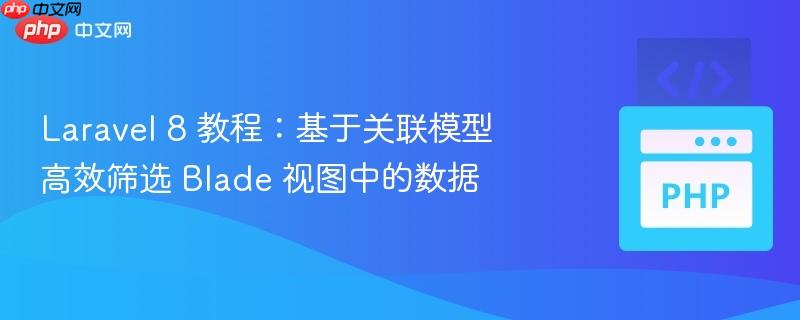
本教程旨在详细指导如何在 Laravel 8 应用中,根据数据库中存储的特定分类列表,高效地筛选产品数据并将其展示在 Blade 视图中。我们将深入探讨利用 Eloquent 关系查询 whereHas 进行数据库层面过滤的推荐方法,以及使用 Collection 的 filter 方法进行内存过滤的替代方案,并提供完整的代码示例、最佳实践和性能考量。
在 Web 开发中,根据特定条件过滤数据是常见需求。本教程聚焦于一个典型场景:你有一个产品列表,每个产品都归属于某个分类。现在,你需要根据一个预定义的“目标分类”列表(例如,只显示“图书”和“衬衫”类的产品),从所有产品中筛选出符合条件的数据,并在 Blade 视图中展示。
为了实现这一目标,我们需要处理以下几个关键点:
为了充分利用 Laravel Eloquent 的强大功能,我们首先需要确保产品和分类之间建立了正确的模型和关系。
假设我们有以下数据库表结构:
基于此,我们需要定义 Product 和 Category Eloquent 模型,并建立它们之间的关系。
<?php
namespace App\Models;
use Illuminate\Database\Eloquent\Factories\HasFactory;
use Illuminate\Database\Eloquent\Model;
use Illuminate\Database\Eloquent\Relations\HasMany;
class Category extends Model
{
use HasFactory;
protected $fillable = ['name'];
/**
* Get the products for the category.
*/
public function products(): HasMany
{
return $this->hasMany(Product::class);
}
}app/Models/Product.php:
<?php
namespace App\Models;
use Illuminate\Database\Eloquent\Factories\HasFactory;
use Illuminate\Database\Eloquent\Model;
use Illuminate\Database\Eloquent\Relations\BelongsTo;
class Product extends Model
{
use HasFactory;
protected $fillable = ['name', 'category_id'];
/**
* Get the category that owns the product.
*/
public function category(): BelongsTo
{
return $this->belongsTo(Category::class);
}
}通过以上定义,Product 模型可以通过 category 方法访问其所属的 Category 模型。
在进行产品筛选之前,我们需要一个明确的“目标分类”列表。这个列表通常存储在数据库中,或者可以是一个硬编码的数组。根据原始问题描述,假设 categories 表(或另一个专门的配置表)提供了我们想要筛选的分类名称。
例如,如果我们的 categories 表中有 id:1, name:'Book' 和 id:2, name:'Shirt' 等记录,并且我们想筛选出所有属于“Book”和“Shirt”的产品,我们可以这样获取目标分类名称数组:
use App\Models\Category;
// 假设我们想要筛选的分类名称是 'Book' 和 'Shirt'
// 这可以是从另一个配置表、用户输入或硬编码获取
$targetCategoryNames = ['Book', 'Shirt'];
// 如果你需要从数据库动态获取这些名称,例如从一个特定的配置表
// $filterCategories = DB::table('filter_categories')->pluck('name')->toArray();
// $targetCategoryNames = $filterCategories;
// 或者如果 'categories' 表就是你的过滤来源,你只想筛选出其中一部分
// $targetCategoryNames = Category::whereIn('name', ['Book', 'Shirt'])->pluck('name')->toArray();在接下来的示例中,我们将直接使用 $targetCategoryNames = ['Book', 'Shirt']; 作为示例。
whereHas 方法是 Eloquent 提供的强大功能,允许你根据关联模型上的条件来过滤父模型。这种方法会在数据库层面生成 SQL JOIN 或 EXISTS 子句,从而实现高效的数据过滤,尤其适用于处理大量数据。
原理:
ProductController.php 中的实现:
<?php
namespace App\Http\Controllers;
use App\Models\Product;
use App\Models\Category; // 确保引入 Category 模型,如果需要从其获取过滤条件
use Illuminate\Http\Request;
class ProductController extends Controller
{
public function index(Request $request)
{
// 1. 定义目标分类名称列表
// 假设这些是你想展示的分类,可以从配置、用户输入或数据库动态获取
$targetCategoryNames = ['Book', 'Shirt'];
// 2. 使用 Eloquent whereHas 进行数据库层面过滤
// 'category' 是 Product 模型中定义的关联方法名
$filteredProducts = Product::whereHas('category', function ($query) use ($targetCategoryNames) {
// 在关联的 categories 表中,查找 name 字段在 $targetCategoryNames 数组中的分类
$query->whereIn('name', $targetCategoryNames);
})->get(); // 执行查询并获取结果
return view('products.index', compact('filteredProducts'));
}
}优点:
如果数据集相对较小,或者你已经出于其他原因加载了所有产品及其关联分类,那么可以使用 Laravel Collection 的 filter 方法在 PHP 内存中进行筛选。
原理:
ProductController.php 中的实现:
<?php
namespace App\Http\Controllers;
use App\Models\Product;
use App\Models\Category;
use Illuminate\Http\Request;
class ProductController extends Controller
{
public function index(Request $request)
{
// 1. 定义目标分类名称列表
$targetCategoryNames = ['Book', 'Shirt'];
// 2. 获取所有产品,并预加载其关联的分类(重要:避免 N+1 问题)
$allProducts = Product::with('category')->get();
// 3. 使用 Collection 的 filter 方法进行内存过滤
$filteredProducts = $allProducts->filter(function (Product $product) use ($targetCategoryNames) {
// 确保产品有分类,并且分类名称在目标列表中
return $product->category && in_array($product->category->name, $targetCategoryNames);
});
// filter 方法会保留原始集合的键,如果需要从 0 开始的连续键,可以使用 values()
$filteredProducts = $filteredProducts->values();
return view('products.index', compact('filteredProducts'));
}
}优点:
缺点:
无论你选择哪种筛选方法,最终控制器都会将一个包含 Product 模型实例的 Eloquent Collection 传递给 Blade 视图。在视图中,你可以像往常一样遍历这个集合并展示产品信息。
resources/views/products/index.blade.php:
<!DOCTYPE html>
<html lang="zh-CN">
<head>
<meta charset="UTF-8">
<meta name="viewport" content="width=device-width, initial-scale=1.0">
<title>筛选后的产品列表</title>
<style>
body { font-family: Arial, sans-serif; margin: 20px; }
ul { list-style: none; padding: 0; }
li { background-color: #f0f0f0; margin-bottom: 5px; padding: 10px; border-radius: 5px; }
h1 { color: #333; }
p { color: #666; }
</style>
</head>
<body>
<h1>筛选后的产品列表</h1>
@if ($filteredProducts以上就是Laravel 8 教程:基于关联模型高效筛选 Blade 视图中的数据的详细内容,更多请关注php中文网其它相关文章!

每个人都需要一台速度更快、更稳定的 PC。随着时间的推移,垃圾文件、旧注册表数据和不必要的后台进程会占用资源并降低性能。幸运的是,许多工具可以让 Windows 保持平稳运行。

Copyright 2014-2025 https://www.php.cn/ All Rights Reserved | php.cn | 湘ICP备2023035733号